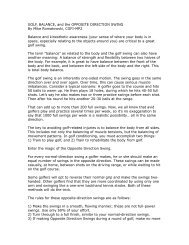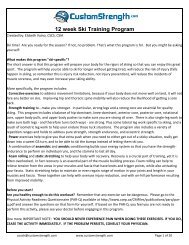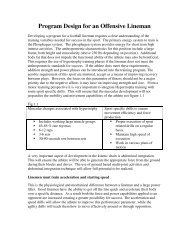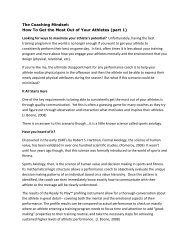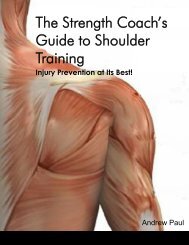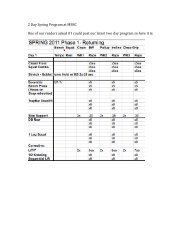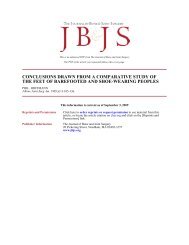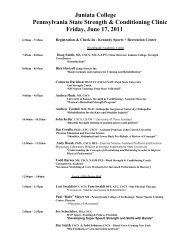Sprint Interval Training - “It's a HIIT - Strength Coach.com
Sprint Interval Training - “It's a HIIT - Strength Coach.com
Sprint Interval Training - “It's a HIIT - Strength Coach.com
Create successful ePaper yourself
Turn your PDF publications into a flip-book with our unique Google optimized e-Paper software.
79. Osterberg KL, Melby CL. Effect of acute resistance exercise on postexercise oxygen consumption<br />
and resting metabolic rate in young women. International Journal of Sport Nutrition and Exercise<br />
Metabolism. 2000; 10(1): 71‐81.<br />
80. Schuenke MD, Mikat RP, McBride JM. Effect of an acute period of resistance exercise on excess post‐exercise<br />
oxygen consumption: Implicationsfor body mass management European Journal of Applied Physiology. 2002; 86:<br />
411‐417.<br />
81. Bjorntorp P. Hormonal Control of Regional Fat Distribution. Hum Reprod. 1997 Oct; 12 Suppl 1: 21‐25.<br />
82. Ottosson M, Lönnroth P, Björntorp P, Edén S. Effect of Cortisol and Growth Hormone on Lipolysis in Human<br />
Adipose Tissue. J Clin Endocrinol Metab. 2000 Feb; 85(2): 799‐803.<br />
83. Treuth MS, Hunter GR, Williams M. Effects of exercise intensity on 24‐h energy expenditure and<br />
substrate oxidation. Med. Sci. Sports Exerc. 1996; 28(9):1138‐43.<br />
84. Juel C. Muscle pH regulation: role of training. Acta. Physiol. Scand. 1998; 162(3):359‐366.<br />
85. Juel C, Halestrap AP. Lactate transport in skeletal muscle ‐ role and regulation of the monocarboxylate<br />
transporter. J. Physiol. 1999; 517(Pt 3):633‐42.<br />
86. Baker SK, McCullagh KJ, Bonen A. <strong>Training</strong> intensity‐dependent and tissue ‐specific increases in lactate uptake<br />
and MCT‐1 in heart and muscle. J. Appl. Physiol. 1998; 84(3):987‐994.<br />
87. Pilegaard H, Domino K, Noland T, Juel C, Hellsten Y, Halestrap AP, Bangsbo J. Effect of high‐intensity exercise<br />
training on lactate/H+ transport capacity in human skeletal muscle. Am. J. Physiol. 1999; 276(2 Pt 1):E255‐61.<br />
88. Burgomaster KA, Heigenhauser GJ, Gibala MJ. Effect of short‐term sprint interval training on human skeletal<br />
muscle carbohydrate metabolism during exercise and time‐trial performance. J Appl Physiol. 2006 Jun; 100(6):<br />
2041‐7.<br />
89. Ebisu T. Splitting the distance of endurance running: on cardiovascular endurance and blood lipids. Jpn. J. Phys.<br />
Educ. 1985: 30: 37‐43.<br />
90. Kraemer WJ, Hamilton AJ, Gordon SE, Trad LA, Reeves JT, Zahn DW, Cymerman A. Plasma changes in beta‐<br />
endorphin to acute hypobaric hypoxia and high intensity exercise. Aviat Space Environ Med. 1991 Aug; 62(8): 754‐<br />
8.<br />
91. Schwarz L, Kindermann W. Changes in beta‐endorphin levels in response to aerobic and anaerobic exercise.<br />
Sports Med. 1992; 13(1): 25‐36.<br />
92. Parry‐Billings M, Budgett R, Koutedakis Y, Blomstrand E, Brooks S, Williams C, Calder PC, Pilling S, Baigrie R,<br />
Newsholme EA. Plasma amino acid concentrations in the overtraining syndrome: possible effects on the immune<br />
system. Med. Sci. Sports Exerc. 1992: 24(12): 1353‐1358.<br />
93. Walsh NP, Blannin AK, Clark AM, Cook L, Robson PJ, Gleeson M. The effects of high‐intensity intermittent<br />
exercise on the plasma concentrations of glutamine and organic acids. Eur. J. Appl. Physiol. Occup. Physiol. 1998;<br />
77(5):434‐8.<br />
43



